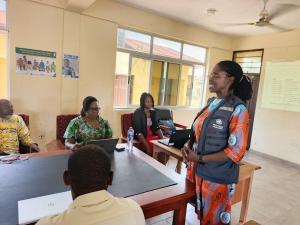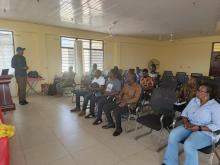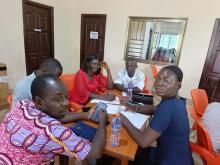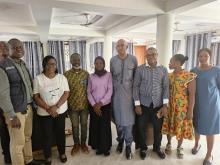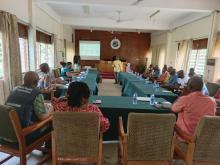WHO supports NADMO to Equip Frontline Responders to Improve Disaster Response
Public Health Emergencies are increasingly becoming complex and frequent and complex, often driven by a convergence of factors including disease outbreaks, climate-related events, technological hazards, and environmental degradation. In such a landscape, effective emergency response depends on coordinated, multi-sectoral efforts grounded in accurate, real-time information.
Thanks to a joint initiative by the World Health Organization (WHO) and the National Disaster Management Organization (NADMO), over 150 multi-sectoral personnel from nine districts in the Volta, Eastern and Greater Accra Regions have been trained in the use of the Multi-sectoral Initial Rapid Assessment (MIRA) tool—a globally recognized framework for conducting joint assessments within the first 72 hours of an emergency.
Speaking at the training, Dr. Guracha Guyo, Emergency Preparedness and Response Team Lead at WHO Country Office, indicated that some emergencies and disasters may be inevitable, but level of preparedness could mitigate effects.
“While some emergencies are unavoidable, our level of preparedness can significantly reduce their impact. This training builds on WHO’s earlier collaboration with NADMO to develop flood contingency plans, and it marks an important step toward strengthening district-level readiness across the regions”, he said.
The training represents a crucial shift from reactive to proactive emergency management. Participants—from Ghana Health Service, NADMO, District Assemblies, and other key agencies—were trained to collect, analyse, and share essential data in a coordinated manner across six key sectors: Health/Nutrition, Protection/Security, Shelter and Non-Food Items, WASH, Food Security, and Education. This ensures that decision-makers at national and sub-national levels receive harmonized, sector-wide insights to inform targeted, life-saving interventions.
Director of Disease Epidemics at NADMO, Ruth Arthur explained the importance of this training. She said, “Timely and accurate information is the foundation of any effective disaster response. The MIRA tool equips our teams to rapidly collect and coordinate critical data, ensuring that every community—no matter how remote—is accounted for and supported during emergencies.”
Prior to this intervention, emergency responses in many districts were often fragmented, with different departments conducting their own assessments and reporting conflicting data. The MIRA tool addresses this critical gap by enabling unified assessments that speed up relief efforts and reduce duplication of effort. Through scenario-based exercises, participants learned how to prioritize needs quickly, ensuring that help reaches the most affected communities in the shortest possible time.
Adapted from the Inter-Agency Standing Committee (IASC) the MIRA tool has been successfully used globally in conflict zones and disaster-prone regions. Its introduction in Ghana signals a major upgrade in the country's emergency response toolkit—one that puts data, speed, and collaboration at the center of action.
For frontline responders, the training was more than professional development, it was personal. Several participants recalled instances where delayed assessments led to critical gaps in response.
“It has been over 2 years since the recent flooding in the district, yet it has been difficult getting harmonized data from the sectors. If we had MIRA then, things would have been different. This training on MIRA tool will resolve this challenge going forward. The next time disaster hits, we’ll know exactly what to do, together" says Mr. Emmanuel Laryea Tetteh, North Tongu District Coordinating Director.
The long-term impact of this initiative is also being planned. NADMO has committed to institutionalizing the MIRA tool into its standard training curriculum, while plans are underway to scale the approach to regional and district levels nationwide. This will ensure sustained capacity-building and institutional memory in emergency preparedness, not just for current emergencies but for those yet to come.
By building a trained cohort of multi-sectoral professionals ready to respond together, Ghana is taking a bold step toward a more resilient and responsive disaster management system. In a world where emergencies can strike without warning, this kind of preparation doesn’t just save time—it saves lives.
For Additional Information or to Request Interviews, Please contact:
Abdul-Lahie Abdul-Rahim Naa
Communications Officer
WHO Ghana Country Office
Email: abdullahiea [at] who.int (abdullahiea[at]who[dot]int)
Tel: +233 20 196 2393
